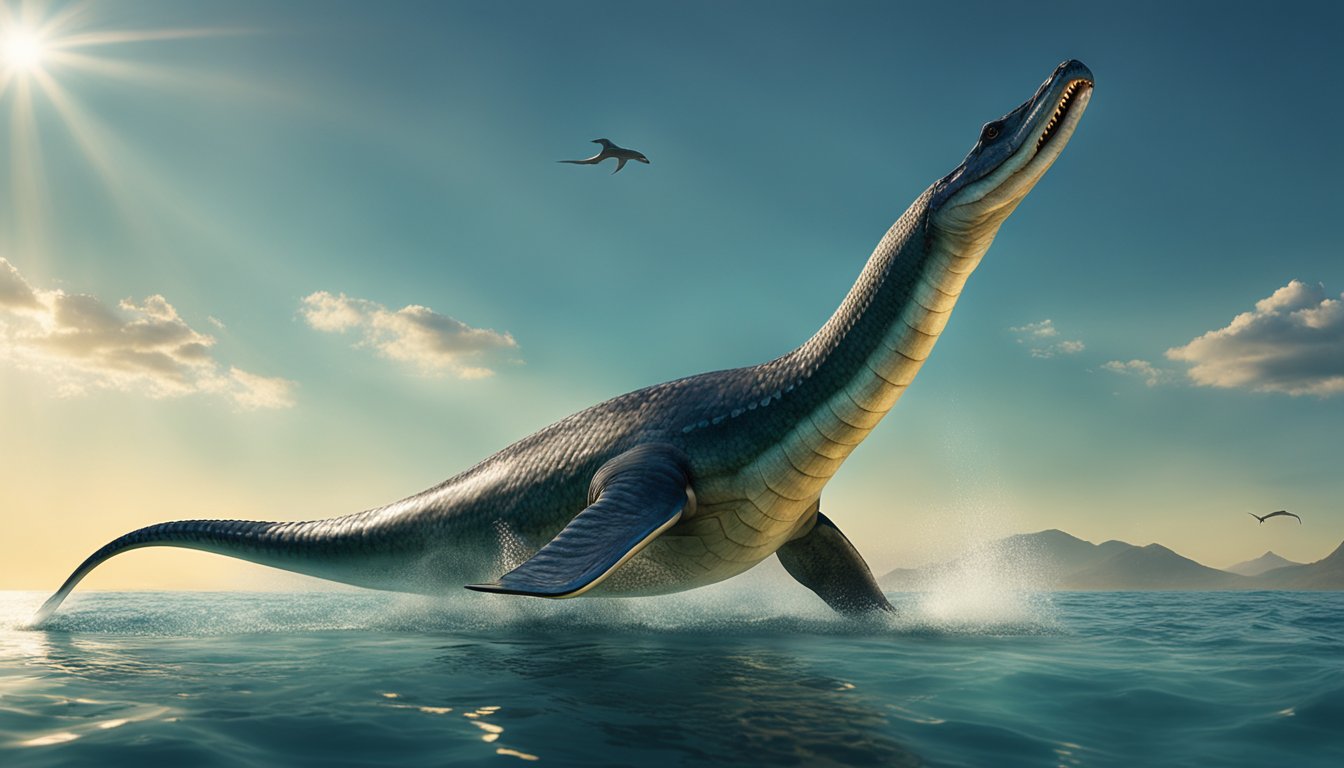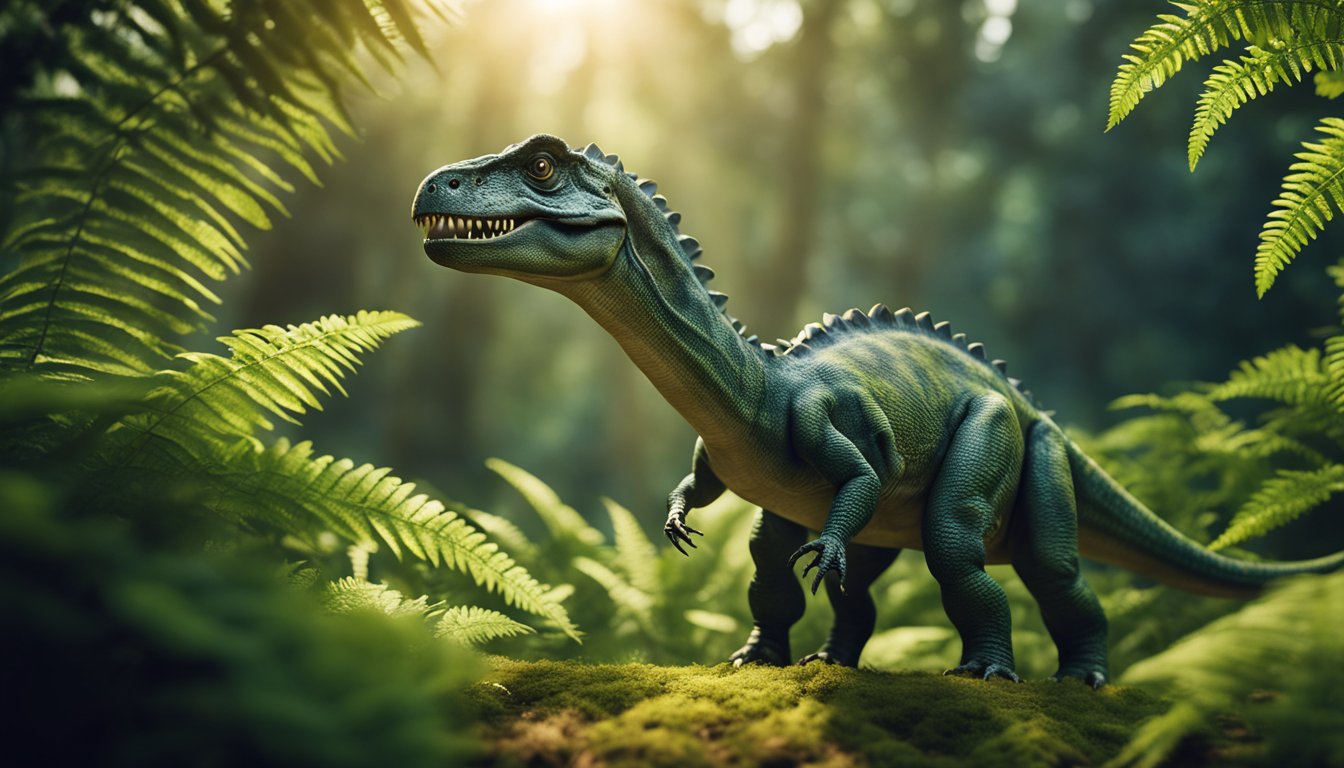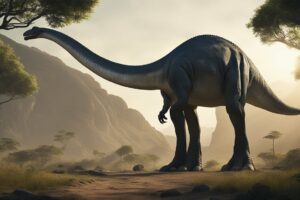Elasmosaurus, the real-life Nessie of prehistoric times, was a marine reptile that lived during the Late Cretaceous period, around 80 million years ago.
This fascinating creature belongs to the group of plesiosaurs, which were among the most successful marine reptiles of all time.
Elasmosaurus, in particular, was known for its exceptionally long neck, which was made up of an incredible 72 vertebrae.

Like all plesiosaurs, Elasmosaurus was well adapted to life in the water.
Its four flippers enabled it to swim with great speed and agility, while its streamlined body shape allowed it to glide effortlessly through the water.
Elasmosaurus was also a carnivorous predator, with a diet that consisted mainly of fish and other small marine animals.
Despite its fearsome reputation, Elasmosaurus was not invulnerable – it was vulnerable to predators in its early life.
Elasmosaurus is just one of many fascinating marine reptiles that once roamed the oceans of the world.
Although they are now extinct, these creatures continue to capture the imagination of people of all ages.
By learning more about Elasmosaurus, we can gain a greater appreciation for the incredible diversity of life that once existed on our planet, and the remarkable adaptations that allowed these creatures to survive and thrive in their watery world.
Discovering the Elasmosaurus
The Elasmosaurus is a prehistoric marine reptile that lived during the Late Cretaceous period, about 80.5 million years ago.
The discovery of this fascinating creature has been a turbulent one, with several paleontologists involved in the search for fossils and the identification of the species.
Fossils and First Discoveries
The first Elasmosaurus fossils were discovered in 1867 near Fort Wallace, Kansas, by a local physician named Theophilus Hunt Turner.
He sent the fossils to Joseph Leidy, a prominent paleontologist at the time, who identified them as belonging to a new species of plesiosaur.
The fossils were later sent to Edward Drinker Cope, an American paleontologist, who named the species Elasmosaurus platyurus in 1868.
This discovery caused a sensation in the scientific community, as it was the first time a long-necked plesiosaur had been identified in North America.
Edward Drinker Cope and the Bone Wars
Edward Drinker Cope was a controversial figure in the history of paleontology.
He was known for his rivalry with another paleontologist, Othniel Charles Marsh, which led to a period of intense competition known as the Bone Wars.
During this time, Cope and Marsh engaged in a race to discover and name as many new species as possible, often resorting to unethical and illegal practices.
Cope was known for his tendency to rush to publish his findings without proper verification, which led to several errors in his work.
Despite these controversies, Cope’s discovery of the Elasmosaurus remains a significant contribution to the field of paleontology.
The species was unique for its extremely long neck, which contained approximately 72 vertebrae – more than any other known animal.
Today, the Elasmosaurus is recognized as one of the most iconic and well-known marine reptiles of the Mesozoic Era.
Its discovery continues to inspire scientists and enthusiasts alike, as they seek to learn more about the fascinating creatures that roamed the earth millions of years ago.
Anatomy of a Marine Predator

Elasmosaurus was a prehistoric marine reptile that lived during the Late Cretaceous period, about 80 million years ago.
It was a member of the Elasmosauridae family, which was a type of plesiosaur, a group of aquatic reptiles that lived in the seas during the Mesozoic era.
The Remarkable Neck
One of the most striking features of Elasmosaurus was its long neck, which was made up of over 70 vertebrae.
The neck alone was longer than the rest of its body, and it was used to hunt for prey in the water.
The neck was so long that it was once believed that Elasmosaurus could not lift its head out of the water, but recent studies have shown that it was indeed capable of doing so.
Flippers and Tail
Elasmosaurus had four flippers that were used to propel itself through the water.
These flippers were similar to the flippers of modern-day dolphins and whales.
The tail of Elasmosaurus was short and stubby, which helped it to maneuver in the water.
Skull and Teeth
The skull of Elasmosaurus was relatively small compared to the rest of its body.
It had a long, slender snout that was filled with sharp, fang-like teeth.
These teeth were used to catch and hold onto prey, which consisted mainly of fish.
Paddles
Elasmosaurus had four paddles that were used to move through the water.
These paddles were similar to the flippers of modern-day sea turtles, and they helped Elasmosaurus to glide gracefully through the water.
Family Elasmosauridae and Genus Elasmosaurus
Elasmosauridae was a family of plesiosaurs that lived during the Mesozoic era. These reptiles were characterized by their long necks and small heads.
Elasmosaurus was a genus of elasmosaurid that lived during the Late Cretaceous period.
It was one of the largest elasmosaurids, reaching lengths of up to 14 meters.
Elasmosaurus was an apex predator and a carnivore.
While they also ingested cephalopods, which are linked to modern squids and octopuses, it appears that fish made up a large portion of their diet.
Despite being ambush predators, they glided and snatched their victim with their fang-like jaws.
Elasmosaurus was a fascinating creature of prehistoric times.
Its long neck, fang-like teeth, and graceful movements through the water make it a wonder of nature.
The Elasmosaurus Habitat and Diet

Life in the Late Cretaceous Waters
Elasmosaurus was a marine reptile that lived during the Late Cretaceous period, around 80 million years ago.
It inhabited the Western Interior Seaway, which was a vast body of water that covered parts of what is now North America.
This prehistoric creature was perfectly adapted to life in the water, with four flippers and a streamlined body that allowed it to move quickly through the water.
Hunting and Feeding Habits
Elasmosaurus was a carnivore that fed on a variety of marine invertebrates, fish, and squid.
It had a long neck, which was composed of approximately 72 vertebrae, that it used to reach out and grab its prey.
The neck was so long that it was once thought to be a disadvantage, but recent studies have shown that it was actually an effective hunting tool.
Elasmosaurus had teeth that were designed for grasping and holding onto its prey.
It would catch its food in its jaws and then use gastroliths, or stomach stones, to help break down the tough exoskeletons of its prey.
Elasmosaurus spent most of its time in the water, but it was also capable of coming to the surface for air.
It was able to hold its breath for long periods of time, which allowed it to stay submerged while hunting for prey.
Fun fact: Elasmosaurus had a diet that was high in cephalopods, which are a type of marine invertebrate that includes squids and octopuses.
In conclusion, Elasmosaurus was a fascinating marine reptile that lived in the Late Cretaceous period.
It was perfectly adapted to life in the water and had a unique hunting style that allowed it to catch a variety of prey.
Elasmosaurus and Popular Culture

The Link to Loch Ness Monster
Elasmosaurus, with its long neck and powerful swimming abilities, has often been compared to the legendary Loch Ness Monster or Nessie.
The similarities between the two creatures are striking, with both being long-necked marine reptiles that lived during the Late Cretaceous period.
While Elasmosaurus is a real prehistoric creature, the existence of Nessie is still a matter of debate and speculation.
The connection between Elasmosaurus and Nessie has been a popular topic in popular culture.
Many people believe that Nessie is a surviving member of the Elasmosaurus species, which somehow managed to survive extinction and continue to live in the depths of Loch Ness.
While there is no scientific evidence to support this theory, it has captured the imagination of people around the world and inspired countless books, movies, and TV shows.
Elasmosaurus in Literature and Media
Elasmosaurus has been a popular subject in literature and media for many years.
In fact, it has been featured in numerous books, movies, and TV shows, often as a fearsome predator that terrorizes the seas.
One of the most famous depictions of Elasmosaurus is in the classic movie “The Land Before Time,” where it is shown as a massive sea monster that tries to attack the main characters.
Elasmosaurus has also been featured in many documentaries and educational programs, where it is often used to teach children about prehistoric marine life.
These programs highlight the incredible size and strength of Elasmosaurus, as well as its unique physical features, such as its long neck and paddle-like limbs.
Overall, Elasmosaurus has played an important role in popular culture, inspiring countless stories and capturing the imagination of people around the world.
While it may not be as well-known as some other prehistoric creatures, such as the T-Rex or the Stegosaurus, it has certainly left its mark on the world of science and entertainment.
Frequently Asked Questions

How are Elasmosaurus fossils important for understanding ancient marine life?
Elasmosaurus fossils provide valuable insights into the ancient marine ecosystem.
Paleontologists can study the fossils to learn about the behavior, diet, and habitat of this prehistoric marine reptile.
By analyzing the fossils, scientists can also determine the age of the rock layers in which the fossils were found.
This information helps us understand the geological history of the Earth and the evolution of marine life.
What features distinguish Elasmosaurus from other marine reptiles?
Elasmosaurus is known for its extremely long neck, which is made up of approximately 72 vertebrae, making it one of the longest necks in the animal kingdom.
This unique feature distinguishes Elasmosaurus from other marine reptiles.
Additionally, Elasmosaurus had four paddle-like limbs that helped it swim through the water with ease.
Can studying Elasmosaurus give clues about the myth of the Loch Ness Monster?
While Elasmosaurus is not the inspiration behind the Loch Ness Monster myth, studying this prehistoric marine reptile can provide insights into the behavior of large aquatic creatures.
Paleontologists can use Elasmosaurus fossils to learn about the hunting and feeding habits of ancient marine reptiles, which could help us understand the behavior of modern-day marine animals.
In what environments are Elasmosaurus fossils typically discovered?
Elasmosaurus fossils are typically found in marine sedimentary rock formations.
These rock formations were once the bottom of ancient oceans, seas, and lakes.
Elasmosaurus fossils have been discovered in various locations around the world, including the United States, Canada, and Australia.
What did Elasmosaurus eat, and how did it hunt its prey?
Elasmosaurus was a carnivorous reptile that fed on fish, squid, and other small marine animals.
Its long neck allowed it to reach out and grab prey with its sharp teeth.
Elasmosaurus likely hunted by silently swimming through the water and surprising its prey from below.
How does the discovery of Elasmosaurus fossils impact our knowledge of dinosaur-era ecosystems?
The discovery of Elasmosaurus fossils helps us understand the diversity of life that existed during the dinosaur era.
By studying the fossils, we can learn about the different species that lived in the ancient oceans and how they interacted with each other.
This information can help us reconstruct the complex ecosystems that existed during this time period.
Fun Fact: Elasmosaurus lived during the Late Cretaceous period, approximately 80 million years ago.






